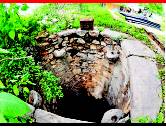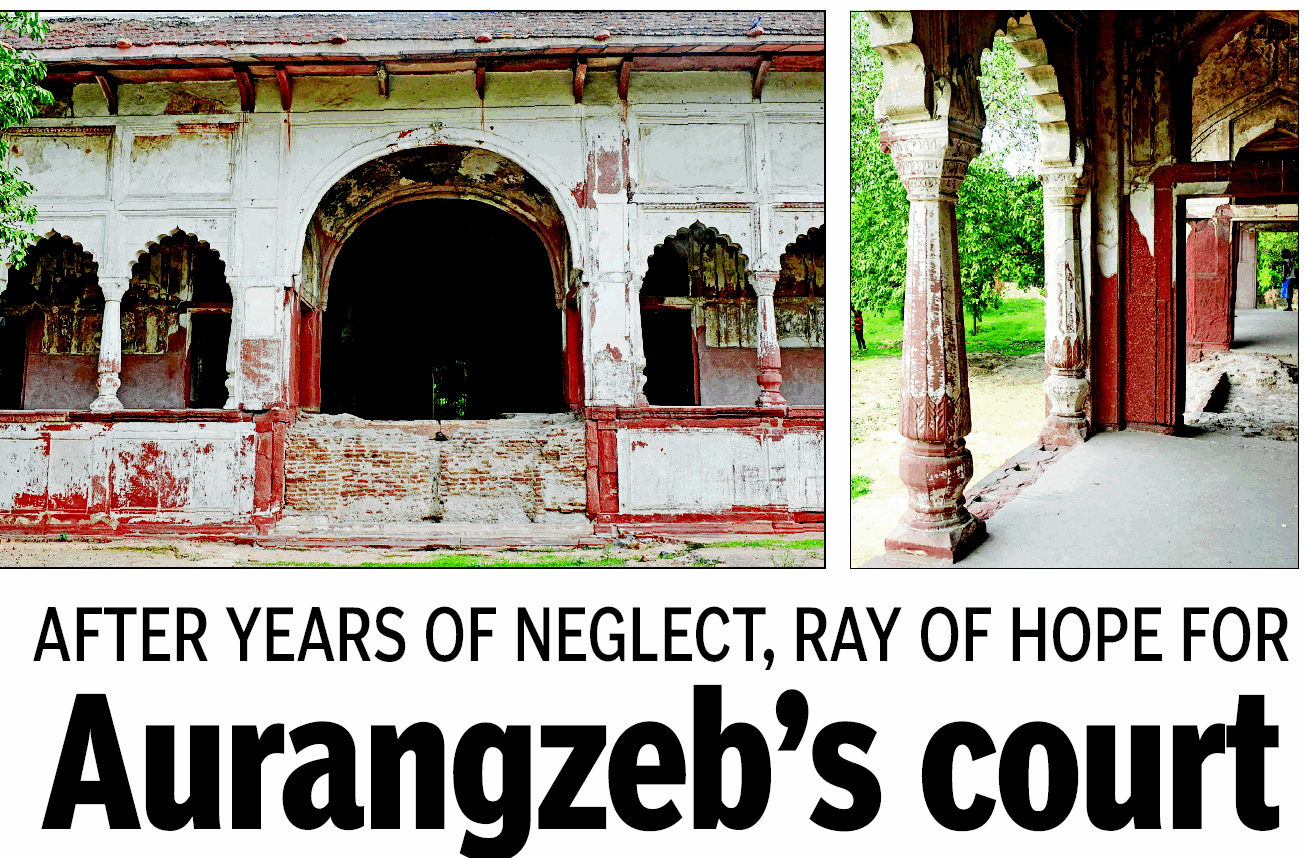Delhi: T
This is a collection of newspaper articles selected for the excellence of their content. |
Contents |
Azimganj Serai
The Delhi cabinet in 2013 approved a plan for the conservation and upkeep of Mughal-era Azimganj Serai monument located on the premises of Delhi Zoo. . The serai clearly stood on the historic Grand Trunk Road
Lal Mahal
The 13th-century Lal Mahal (Red/ Ruby Palace) in the Nizamuddin area, is one of the oldest Islamic palaces of India, is located in the ‘prohibited zone’ of four centrally protected monuments— Nizamuddin Baoli, Barakhamba, Chausath Khamba and Mirza Ghalib’s tomb. It is not an ASI-protected site. In 2013 construction activities took place around it.
Mehram Nagar
Mughal courtier’s lost garden
Historic ruins at Mehram Nagar are disappearing and may not stand the test of time for long
Richi Verma | TNN
The Times of India 2013/07/22
The minute you drive out of Indira Gandhi International Airport, you pass Mehram Nagar. Only the cognoscenti know it’s home to ruins of a lost era.
A gateway, a mosque, an enclosing wall, a katra and an authentic Mughal garden—all in various stages of dilapidation and decay—stand testimony to the historicity of the settlement set up in mid-17th century and named after Mughal courtier Mehram Khan.
Only one of the three gateways to the 17th-century Mughal sarai stands today. One other vanished decades ago and remnants of the third can be seen between a cluster of shops and houses. The surviving gateway is an imposing double-storey structure with pointed arch openings enclosed by a cusped arch façade. The side bays have been encroached by shopowners but the fact that the wooden gates are buried at least two feet deep stands testimony to their age. A few feet away, construction work for a Metro station is on full swing.
Some distance away lie remains of the sarai wall. Portions of it can be seen inside the village interspersed by new constructions and houses. Made of rubble masonry, the wall is six metres high and crowned by battlements and vaulted chambers. A significant chunk of the western wall vanished several years ago when a road was laid between Mehram Nagar and a large green area on the other side. A parking lot being built adjacent to the southern wall has taken a toll.
The farmland on the opposite side of Mehram Nagar, is owned by the defence ministry. It houses portions of the enclosing wall and a baoli and is known as Mehram Khan’s garden. The ruins stand forgotten, made inaccessible by thick foliage and dense vegetation.
Yet they can be conserved to make Mehram Nagar a prime tourist attraction especially as it’s located so close to the airport, say experts.
The state archaeology department has identified some of the ruins for conservation and protection in Phase III of a project, the MoU of which has been signed by Intach and Delhi government (Phase II is yet to take off), but “in the meantime, the government should keep a tab and ensure the ruins do not fall prey to urbanization. With so much construction work happening around Mehram Nagar, the ruins could disappear completely”, an official said.
Mehram Khan
Mehram Khan was a powerful noble in the courts of Shah Jahan and Aurangzeb
Mehram Nagar village, opposite the domestic airport, was established during his reign
Here, ruins of gateways, mosque, katra and enclosure wall are found
Only one out of three old gateways still survives. The imposing wooden doors are similar to those at Red Fort
Portions of the eastern and southern walls that surrounded Sarai Mehram Nagar still exist
Construction work by Delhi Metro and an upcoming parking lot threaten the ruins
None of the structures are protected, though they have been identified for conservation and protection by the state archaeology department
Shalimar Bagh
Sheesh Mahal
The Times of India 2013/07/04
Sunder Nursery
RETURN OF THE MUGHAL
Sunder Nursery was a Mughal garden once, and will be again in
Richi Verma | TNN
The Times of India 2013/08/31
The Sunderwala Burj, sleeps undisturbed behind the tall gates of Sunder Nursery just across the road. Few know the nursery as anything more than a seedbed for the trees and flowers in Lutyens’ Delhi, but that is set to change soon.
Quietly, the sprawling property is being transformed into an authentic Mughal garden laid around a central axis with monuments, fountains, water bodies and a large variety of tree and bird species. The project’s landscape planner, Mohammed Shaheer, says the aim is to conserve the environment and create a “major landscaped space” aligning nature and utility in a garden.
The Aga Khan Trust for Culture (AKTC), is partnering Archaeological Survey of India and the site owner, Central Public Works Department, in the project
The project was conceived while AKTC was restoring the gardens of Humayun’s Tomb during 1997-2003. When they are completed in 2015, the Sunder Nursery gardens will cover 100 acres across the nursery and the adjoining Batashewala complex. Shaheer says the gardens will have a microhabitat zone for plants found on Delhi’s ridge, river banks, plains and other zones.
Edged by nine mounds, the microhabitat zone will replicate Delhi’s original landscape to increase environmental awareness among the 3 lakh schoolchildren who visit Humayun’s Tomb every year. AKTC has recorded 1,800 mature trees of more than 200 species at the nursery on a geographic information system (GIS) and planted another 100-odd species. “Biodiversity studies in 2012 documented 54 species of resident birds and 24 species of butterflies,’’ said an official.
Besides the Sunderwala Burj, the nursery also has eight early-Mughal era monuments that have been restored after years of neglect. Three of them—Sunderwala Burj, Lakkarwala Burj and Sunderwala Mahal—have been declared monuments of national importance by the ASI. However, other structures, including ancient wells, a Mughal pavilion, a mosque and several graveyards are unprotected but equally striking. Two monuments in the adjunct Bateshewala complex are also with ASI.
For the complex as a whole, the changes mark a return to past glory. Before the British turned it into a nursery in 1913, it was called Azim Bagh. “Historically, the entire area from Humayun’s Tomb to Millennium Park (along the Yamuna) was a Mughal garden,” says Ashok Khurana, retired director general of CPWD in whose tenure the project was conceived.
AKTC has offered to manage Sunder Nursery until it becomes financially sustainable. “Discussions for postproject management of the park are now in an advanced state with AKTC underwriting all management and maintenance costs for 10 years,’’ said Ratish Nanda, project director of AKTC. Already, parallels are being drawn between the gardens and New York’s iconic Central Park.
CITY’S TREE SANCTUARY
Together with Delhi zoo, Purana Qila, Millennium Park and Humayun’s Tomb, the nursery stands in an uninterrupted Mughal landscape spanning more than 1,000 acres More than 1,800 mature trees of over 200 species at the nursery recorded on a geographic information system (GIS). Hundred more species planted Biodiversity studies conducted by AKTC in 2012 documented 54 species of resident birds and 24 species of butterfl ies
Almost 20 acres exclusively for CPWD’s nursery functions Central axis inspired by the Persian carpet design with fountains, sandstone lights all carved with hand in true Mughal style A number of Mughal monuments can also be found








